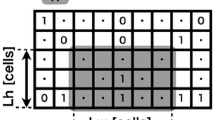Abstract
This paper presents the characterization of Rule 110 as a block substitution system of three symbols. Firstly, it is proved that the dynamics of Rule 110 is equivalent to cover the evolution space with triangles formed by the cells of the automaton. It is hence demonstrated that every finite configuration can be partitioned in several blocks of symbols and, that the dynamics of Rule 110 can be reproduced by a set of production rules applied to them. The shape of the blocks in the current configuration can be used for knowing the number of them in the next one; with this, the evolution of random configurations, ether and gliders can be modeled.
Similar content being viewed by others
References
Wolfram S (1986) Theory and applications of cellular automata. World Scientific Press, Singapore
Cook M (2004) Universality in elementary cellular automata. Complex Syst 15: 1–40
Neary T, Woods D (2006) P-completeness of cellular automaton Rule 110. In: International colloquium on automata languages and programming (ICALP). LNCS, vol 4051, pp 132–143
Richard G (2008) Rule 110: universality and catenations. In: Durand B (ed) Proceedings of the first symposium on cellular automata “Journées Automates Cellulaires”, pp 141–160
Martínez G, McIntosh H, Seck-Tuoh-Mora J, Chapa-Vergara S (2008) Determining a regular language by glider-based structures called phases f i _1 in rule 110. J Cell Autom 3: 231–270
McIntosh H (1999) Rule 110 as it relates to the presence of gliders. http://delta.cs.cinvestav.mx/~mcintosh/comun/RULE110W/RULE110.html. Accessed 15 Aug 2009
Martínez G, McIntosh H (2001) ATLAS: collisions of gliders like phases of ether in Rule 110. http://delta.cs.cinvestav.mx/~mcintosh/comun/summer2001/bookcollisionsHtml/bookcollisions.html. Accessed 16 Feb 2010
Wolfram S (2002) A new kind of science. Wolfram Media, Champaign
Kari J (1996) Representation of reversible cellular automata with block permutations. Math Syst Theory 29: 47–61
Author information
Authors and Affiliations
Corresponding author
Additional information
Communicated by R. Neruda.
Rights and permissions
About this article
Cite this article
Seck-Tuoh-Mora, J.C., Martínez, G.J., Hernández-Romero, N. et al. Elementary cellular automaton Rule 110 explained as a block substitution system. Computing 88, 193–205 (2010). https://doi.org/10.1007/s00607-010-0096-x
Received:
Accepted:
Published:
Issue Date:
DOI: https://doi.org/10.1007/s00607-010-0096-x




